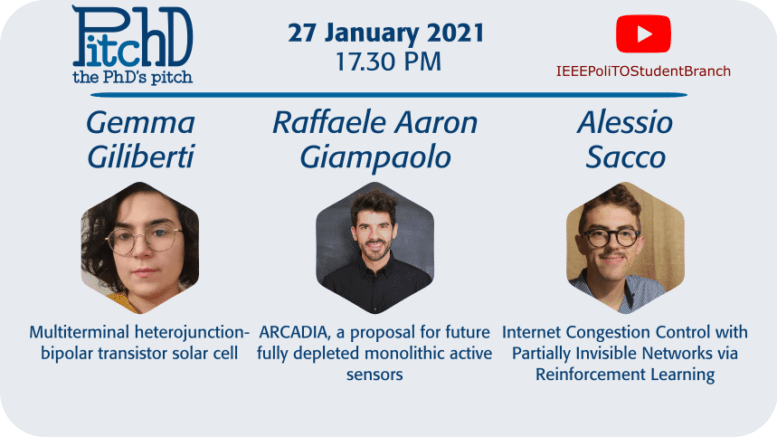Here’s the 1st PitchD – the PhD’s pitch. Our PhD IEEE Student Members explain to students, colleagues and professors their research.
Multiterminal heterojunction-bipolar transistor solar cell
Ms. Gemma Giliberti
Dept. of Electronics and Telecommunication (DET), Politecnico di Torino
The photovoltaic (PV) technology, blending cheapness and sustainability, represents a viable alternative to the fossil-fuel system responsible of climate change and global warming. Nowadays, the terrestrial PV market is dominated by c-Si single-junction solar cell achieving an efficiency close to its theoretical limit. However, in recent years, a good solution to overcome this limit is found in Perovskite-Silicon tandem solar cells thanks to the low manufacturing costs as well as the strong solar absorption of the perovskite (PVK) material. Aiming at increasing the PVK/Si solar efficiency and overcoming several constraints of the series connected double junction cell, such as the current matching and the need of tunnel junctions, it is studied an alternative architecture: the three-terminal bipolar transistor (3T-HBT) solar cell. To evaluate the performance potential and design optimization of this novel PVK/Si 3T-HBTsc, the classical Hovel model is extended to deal with the 3T-HBT structure demonstrating efficiencies up to 28.6%.
ARCADIA, a proposal for future fully depleted monolithic active sensors
Mr. Raffaele Aaron Giampaolo
Dept. of Electronics and Telecommunication (DET), Politecnico di Torino
Fully depleted monolithic active pixel sensors (FD-MAPS) are the future of particle and radiation detectors. Full depletion improves charge collection timing and signal to noise ratio versus power dissipated. Furthermore, a smaller material budget and less interconnections push down production costs and time. The approach envisioned by the ARCADIA (Advanced Readout CMOS Architectures with Depleted Integrated sensor Arrays) collaboration consists in implementing the front-end electronics in a deep p-well embedded in an n-doped epitaxial layer, decreasing the sensor capacitance and effectively decoupling the substrate from the electronics. A patterned backside, with appropriate guard rings, allows the necessary high voltage to uniformly deplete the full wafer thickness. Despite the backside implants, the sensor fabrication is fully compatible with a standard CMOS production line. The talk will present the current R&D progress and results of tests on small-scale matrices and test structures.
Internet Congestion Control with Partially Invisible Networks via Reinforcement Learning
Mr. Alessio Sacco
Dept. of Control and Computer Engineering (DAUIN), Politecnico di Torino
Alternative internet congestion control strategies have been proposed since the TCP’s birth, mainly because of the variance of conditions and assumptions in different network scenarios, e.g., cellular versus data center networks. However, years of research on transport protocols have not solved the tussle between in-network and end-to-end congestion control. Recently, the community has proposed a few transport protocols driven by machine learning, nonetheless limited to end-to-end approaches. This talk will introduce a transport protocol based on reinforcement learning, whose goal is to select the proper congestion window learning from end-to-end features and network signals, when available. A solution like the one presented has been proved to converge to a fair resource allocation after the learning overhead. Finally, it can provide higher throughput and lower delays compared to benchmark solutions based on end-to-end or in-network congestion control.


Be the first to comment on "PitchD 2021 edition: the 1st PitchD [ONLINE]"